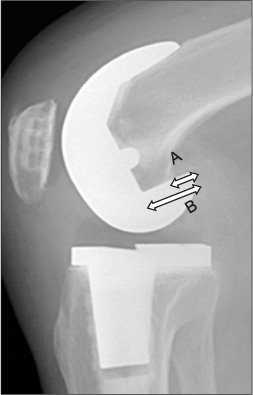J Korean Orthop Assoc.
2012 Feb;47(1):35-40. 10.4055/jkoa.2012.47.1.35.
Early Aseptic Loosening after Total Knee Replacement Using Legacy Posterior Stabilized-Flex Prosthesis
- Affiliations
-
- 1Department of Orthopaedic Surgery, Gangneung Asan Hospital, Ulsan University College of Medicine, Gangneung, Korea. theknee@naver.com
- KMID: 1439990
- DOI: http://doi.org/10.4055/jkoa.2012.47.1.35
Abstract
- PURPOSE
We analyzed the patterns and causative factors of early aseptic loosening after total knee arthroplasty (TKR) using a legacy posterior stabilized (LPS)-flex prosthesis.
MATERIALS AND METHODS
We examined 483 cases that occurred in 311 patients who underwent TKR using LPS-flex by single surgeon between August 2001 and March 2007 and who were followed-up for at least 2 years. The loosened group included 25 cases that exhibited early aseptic loosening on radiograph, the remaining 458 cases were regarded as the control group, and analysis was performed.
RESULTS
The mean loosening period was 34.7 months and femoral component loosening alone was found in 22 cases (88%). There were no statistically significant differences in age, body mass index, or pre-operative range of motion between the 2 groups, but varus deformity was more severe in the loosened group (mean 8.92degrees) than in the control group (mean 5.21degrees) (p=0.003). Protrusion of the femoral component proximally over posterior condyle of the distal femur were more prominent in the loosened group (mean 20.3%) than in the control group (mean 13.4%) (p=0.001).
CONCLUSION
Early loosening after TKR using LPS-flex prosthesis developed mostly in the femoral component. Choosing a proper size for the femoral component and cutting level for the distal femur should be considered.
MeSH Terms
Figure
Cited by 1 articles
-
Are Western Knee Designs Dimensionally Correct for Korean Women? A Morphometric Study of Resected Femoral Surfaces during Primary Total Knee Arthroplasty
Jun-Bae Kim, Suk-Joo Lyu, Hyung Wook Kang
Clin Orthop Surg. 2016;8(3):254-261. doi: 10.4055/cios.2016.8.3.254.
Reference
-
1. Bellemans J, Banks S, Victor J, Vandenneucker H, Moemans A. Fluoroscopic analysis of the kinematics of deep flexion in total knee arthroplasty Influence of posterior condylar offset. J Bone Joint Surg Br. 2002. 84:50–53.2. Argenson JN, Scuderi GR, Komistek RD, Scott WN, Kelly MA, Aubaniac JM. In vivo kinematic evaluation and design considerations related to high flexion in total knee arthroplasty. J Biomech. 2005. 38:277–284.
Article3. Li G, Most E, Sultan PG, et al. Knee kinematics with a high-flexion posterior stabilized total knee prosthesis: an in vitro robotic experimental investigation. J Bone Joint Surg Am. 2004. 86:1721–1729.
Article4. Li G, Zayontz S, DeFrate LE, Most E, Suggs JF, Rubash HE. Kinematics of the knee at high flexion angles: an in vitro investigation. J Orthop Res. 2004. 22:90–95.
Article5. Ritter MA, Campbell ED. Effect of range of motion on the success of a total knee arthroplasty. J Arthroplasty. 1987. 2:95–97.
Article6. Sharma A, Komistek RD, Scuderi GR, Cates HE Jr. High-flexion TKA designs: what are their in vivo contact mechanics? Clin Orthop Relat Res. 2007. 464:117–126.7. Sultan PG, Most E, Schule S, Li G, Rubash HE. Optimizing flexion after total knee arthroplasty: advances in prosthetic design. Clin Orthop Relat Res. 2003. (416):167–173.8. Cho SD, Ko SH, Park MS, et al. Early loosening of primary high flex total knee arthroplasty: report of 4 cases. J Korean Knee Soc. 2006. 18:107–111.9. Han HS, Kang SB, Yoon KS. High incidence of loosening of the femoral component in legacy posterior stabilised-flex total knee replacement. J Bone Joint Surg Br. 2007. 89:1457–1461.
Article10. King TV, Scott RD. Femoral component loosening in total knee arthroplasty. Clin Orthop Relat Res. 1985. (194):285–290.
Article11. Ranawat CS. Design may be counterproductive for optimizing flexion after TKR. Clin Orthop Relat Res. 2003. (416):174–176.
Article12. Ritter MA. High-flexion knee designs: more hype than hope? In the affirmative. J Arthroplasty. 2006. 21:4 Suppl 1. 40–41.13. Kim TH, Lee DH, Bin SI. The NexGen LPS-flex to the knee prosthesis at a minimum of three years. J Bone Joint Surg Br. 2008. 90:1304–1310.
Article14. Nagura T, Dyrby CO, Alexander EJ, Andriacchi TP. Mechanical loads at the knee joint during deep flexion. J Orthop Res. 2002. 20:881–886.
Article15. Thambyah A, Goh JC, De SD. Contact stresses in the knee joint in deep flexion. Med Eng Phys. 2005. 27:329–335.
Article16. Zhang Y, Hunter DJ, Nevitt MC, et al. Association of squatting with increased prevalence of radiographic tibiofemoral knee osteoarthritis: the Beijing Osteoarthritis Study. Arthritis Rheum. 2004. 50:1187–1192.
Article17. Nakayama K, Matsuda S, Miura H, Iwamoto Y, Higaki H, Otsuka K. Contact stress at the post-cam mechanism in posterior-stabilised total knee arthroplasty. J Bone Joint Surg Br. 2005. 87:483–488.
Article18. Zelle J, Janssen D, Van Eijden J, De Waal Malefijt M, Verdonschot N. Does high-flexion total knee arthroplasty promote early loosening of the femoral component? J Orthop Res. 2011. 29:976–983.
Article
- Full Text Links
- Actions
-
Cited
- CITED
-
- Close
- Share
- Similar articles
-
- Comparison of Revision Rates Due to Aseptic Loosening between High-Flex and Conventional Knee Prostheses
- Causes of Femoral Component Radiologic Abnormality After Total Knee Arthroplasty Using Legacy Posterior Stabilized-Flex Prosthesis
- Evaluation of Postoperative Range of Motion and Functional Outcomes after Cruciate-Retaining and Posterior-Stabilized High-Flexion Total Knee Arthroplasty
- Advantage of Minimal Anterior Knee Pain and Long-term Survivorship of Cemented Single Radius Posterior-Stabilized Total Knee Arthroplasty without Patella Resurfacing
- Two- to Four-Year Follow-up Results of Total Knee Arthroplasty Using a New High-Flexion Prosthesis



